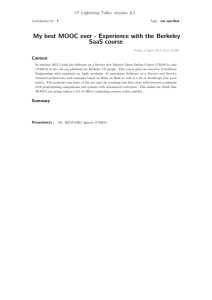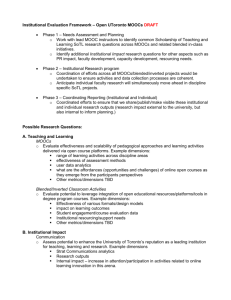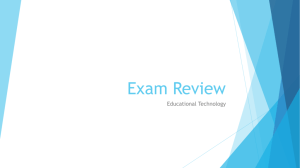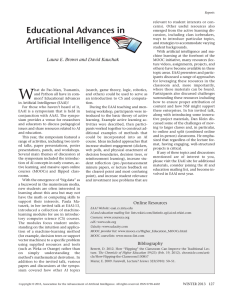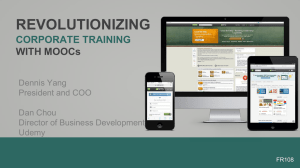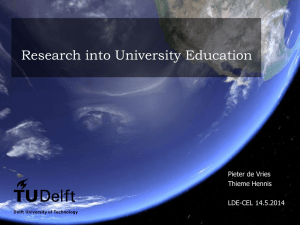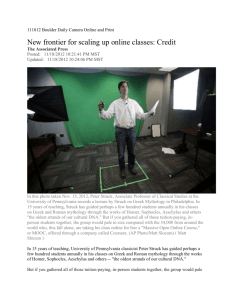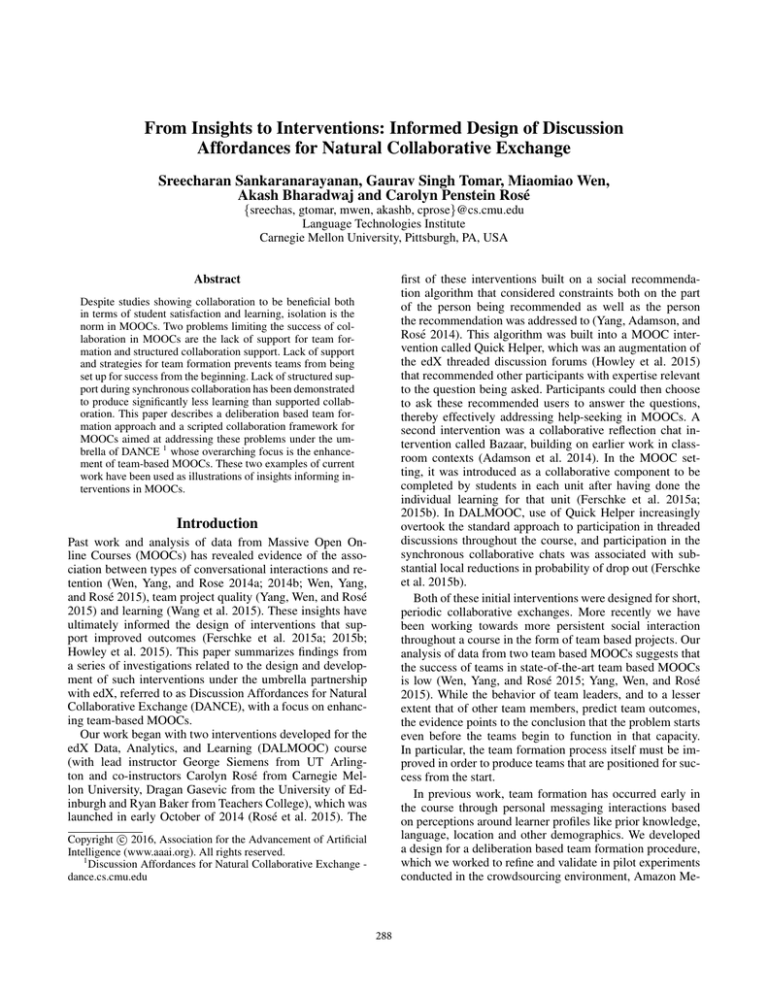
From Insights to Interventions: Informed Design of Discussion
Affordances for Natural Collaborative Exchange
Sreecharan Sankaranarayanan, Gaurav Singh Tomar, Miaomiao Wen,
Akash Bharadwaj and Carolyn Penstein Rosé
{sreechas, gtomar, mwen, akashb, cprose}@cs.cmu.edu
Language Technologies Institute
Carnegie Mellon University, Pittsburgh, PA, USA
first of these interventions built on a social recommendation algorithm that considered constraints both on the part
of the person being recommended as well as the person
the recommendation was addressed to (Yang, Adamson, and
Rosé 2014). This algorithm was built into a MOOC intervention called Quick Helper, which was an augmentation of
the edX threaded discussion forums (Howley et al. 2015)
that recommended other participants with expertise relevant
to the question being asked. Participants could then choose
to ask these recommended users to answer the questions,
thereby effectively addressing help-seeking in MOOCs. A
second intervention was a collaborative reflection chat intervention called Bazaar, building on earlier work in classroom contexts (Adamson et al. 2014). In the MOOC setting, it was introduced as a collaborative component to be
completed by students in each unit after having done the
individual learning for that unit (Ferschke et al. 2015a;
2015b). In DALMOOC, use of Quick Helper increasingly
overtook the standard approach to participation in threaded
discussions throughout the course, and participation in the
synchronous collaborative chats was associated with substantial local reductions in probability of drop out (Ferschke
et al. 2015b).
Both of these initial interventions were designed for short,
periodic collaborative exchanges. More recently we have
been working towards more persistent social interaction
throughout a course in the form of team based projects. Our
analysis of data from two team based MOOCs suggests that
the success of teams in state-of-the-art team based MOOCs
is low (Wen, Yang, and Rosé 2015; Yang, Wen, and Rosé
2015). While the behavior of team leaders, and to a lesser
extent that of other team members, predict team outcomes,
the evidence points to the conclusion that the problem starts
even before the teams begin to function in that capacity.
In particular, the team formation process itself must be improved in order to produce teams that are positioned for success from the start.
In previous work, team formation has occurred early in
the course through personal messaging interactions based
on perceptions around learner profiles like prior knowledge,
language, location and other demographics. We developed
a design for a deliberation based team formation procedure,
which we worked to refine and validate in pilot experiments
conducted in the crowdsourcing environment, Amazon Me-
Abstract
Despite studies showing collaboration to be beneficial both
in terms of student satisfaction and learning, isolation is the
norm in MOOCs. Two problems limiting the success of collaboration in MOOCs are the lack of support for team formation and structured collaboration support. Lack of support
and strategies for team formation prevents teams from being
set up for success from the beginning. Lack of structured support during synchronous collaboration has been demonstrated
to produce significantly less learning than supported collaboration. This paper describes a deliberation based team formation approach and a scripted collaboration framework for
MOOCs aimed at addressing these problems under the umbrella of DANCE 1 whose overarching focus is the enhancement of team-based MOOCs. These two examples of current
work have been used as illustrations of insights informing interventions in MOOCs.
Introduction
Past work and analysis of data from Massive Open Online Courses (MOOCs) has revealed evidence of the association between types of conversational interactions and retention (Wen, Yang, and Rose 2014a; 2014b; Wen, Yang,
and Rosé 2015), team project quality (Yang, Wen, and Rosé
2015) and learning (Wang et al. 2015). These insights have
ultimately informed the design of interventions that support improved outcomes (Ferschke et al. 2015a; 2015b;
Howley et al. 2015). This paper summarizes findings from
a series of investigations related to the design and development of such interventions under the umbrella partnership
with edX, referred to as Discussion Affordances for Natural
Collaborative Exchange (DANCE), with a focus on enhancing team-based MOOCs.
Our work began with two interventions developed for the
edX Data, Analytics, and Learning (DALMOOC) course
(with lead instructor George Siemens from UT Arlington and co-instructors Carolyn Rosé from Carnegie Mellon University, Dragan Gasevic from the University of Edinburgh and Ryan Baker from Teachers College), which was
launched in early October of 2014 (Rosé et al. 2015). The
c 2016, Association for the Advancement of Artificial
Copyright Intelligence (www.aaai.org). All rights reserved.
1
Discussion Affordances for Natural Collaborative Exchange dance.cs.cmu.edu
288
chanical Turk. That procedure offered opportunities for students to interact in a project-relevant way in the discussion
forums with members of the whole course community prior
to team formation. Based on observed discussion processes,
which can be automatically analyzed, teams were formed using a constraint satisfaction algorithm that is able to assign
all students to teams in such a way that the average team
quality is maximized (by a criterion based on qualities of
observed interaction in the discussion forum).
In our continued work we are using the insights gained
from these studies to form design principles with high internal validity (using controlled experimentation within the
crowdsourcing environment) which we will then test in realistic deployment on the edX platform. The design principles
are being encoded into future offerings of DANCE as a way
of demonstrating the integration and study of artificial intelligence in MOOC settings.
The rest of the paper will first discuss the resources currently available through DANCE as well as planned additions to the DANCE repertoire for supporting scripted collaboration in MOOCs. The section on ”Deliberation-based
Team Formation” describes how insights from a crowdsourced study are being replicated in a real MOOC deployment so that intelligent support for team formation can be
incorporated to set teams up for success.
among an older student demographic (Ke and Xie 2009;
Keeton 2004) akin to those found in MOOCs, isolation has
been the norm in MOOCs, and so far there has been a shortage of affordances for collaborative learning experiences
in those platforms. One notable exception is the NovoEd
platform5 which frequently requires students to work in
groups to successfully complete courses. The ”Technology
Entrepreneurship” course offered on the platform reported a
completion rate of 65%(Eesley 2014) which seems remarkable in comparison with the far lower completion rates reported by standard MOOCs. This suggests other platforms
might benefit from offering collaboration opportunities for
students, especially if they can be properly structured and
supported.
Encouraged by this, DANCE is making progress towards
supporting scripted collaboration in MOOCs using two major approaches.
Discussion Affordances for Natural
Collaborative Exchange
The LTI approach is appealing because it enables one time
development and multiple deployments. It is however reliant
on the platform to expose services and data in an LTI compliant fashion. The standard itself is amorphous and may
change with time and requirements. The XBlock on the
other hand is tightly coupled to the edX platform. edX’s
own use of the XBlock framework guarantees availability
and compliance. It also allows us to anticipate and plan integrations with features like Teams6 and Cohorts7 which are
scheduled to be released soon. The XBlock can potentially
be used by all platforms that run on the open edX framework including Lagunita8 , MOOC.org9 and Google Course
Builder. An overview of the kinds of support that the XBlock
enables has been described below.
Our XBlock design is set up to be customizable, providing
opportunities for individual learning, potentially supported
by intelligent tutoring systems augmented with collaborative phases. Thus, the XBlock is customizable, with a configurable pre-collaboration step that is an individual activity
that provides instructions and preparation materials. Materials in the form of audio, text and video can be embedded
using edX Studio without the need to modify the XBlock
code. Group matching and role allocation by default is random.
Due to the varied nature of an intelligent tutoring system
(ITS), the functionality isn’t planned on being built into the
XBlock. The ITS can instead be integrated by hosting it as
• Learning Tools Interoperability (LTI) - LTI defines the
integration of third party tools into LTI compliant MOOC
platforms such as edX and Coursera. Bazaar, the collaborative reflection chat intervention has been successfully
integrated into edX course using this method.
• Open edX XBlocks - An XBlock is a modular and hierarchical construct used in the Open edX. An XBlock is
analogous to a div in a web application.
DANCE is a satellite working group that seeks to draw from
two decades of research in Computer Supported Collaborative Learning to enhance instructionally beneficial discussion opportunities available to students involving researchers and developers from multiple universities, foundations and industrial organizations. A particular goal is to
apply artificial intelligence approaches, such as text mining,
recommender systems, and intelligent conversational agents
to make online collaborative learning experiences effective.
Another goal of DANCE is to aggregate CSCL/MOOC
resources in the discussion affordances space and make them
available to the community at large. A Google Scholar account2 and a resources page3 serve this end. DANCE will
offer DiscourseDB4 , a data infrastructure project designed
to bridge data sources from multiple platforms for hosting
different learning experiences with a vision of providing a
common data model designed to accommodate data from
diverse sources including but not limited to chat, threaded
discussions, blogs, twitter, wikis, and text messages. A discussion forum XBlock for the edX platform will also be released as a first step toward enabling script based support for
collaboration in MOOCs.
Scripted Collaboration in MOOCs
Despite studies indicating the advantages of scripted collaboration with respect to learning and student satisfaction
5
novoed.com
open.edx.org/features/teams
7
open.edx.org/features/cohort-specific-content
8
lagunita.stanford.edu/about
9
www.mooc.org
6
2
dance.cs.cmu.edu/scholar
dance.cs.cmu.edu/resources
4
discoursedb.github.io
3
289
Experimental Setup
The collaboration involved students working in groups to
accomplish a knowledge integration task. The collaborative
task required participants to justify the selection of one of
four given energy plans for a city. An energy plan is a combination of up to 4 different energy sources, each of which is
represented by one of the group participants as part of a Jigsaw paradigm. In the constraint satisfaction proposal writing
task then, the goal was to require each member to represent
their assigned perspective also considering how it relates to
the perspectives of others in the group. A four-step experimental procedure was designed as follows.
Figure 1: Incorporation of an Intelligent
Tutoring System
• Preparation - To prepare for the Jigsaw task, each participant was assigned to read an article about the pros and
cons of a single energy source. To reinforce their learning,
a multiple choice quiz with feedback was required to be
answered.
Figure 2: Incroporation of a Script
• Pre-task - Given a city with 5 requirements, the individual was required to write a proposal, which was then
posted to the discussion forum.
an external service or by modifying the XBlock implementation. The incorporation process is shown in Figure 1.
For the collaboration phase, simple automated scripts can
be natively implemented in the XBlock in the absence of the
above ITS design. The server may have to issue tasks based
on a static script as shown in Figure 2.
• Deliberation - Each participant was then required to write
at least 5 replies to the other proposals. To encourage
transactivity, the task instruction when replying to a post
encouraged participants to ”elaborate, build upon, question or argue against the ideas presented in that post,
drawing from the argumentation in your own proposal
where appropriate.”
• Collaboration - The participants were then required to
collaboratively write a proposal recommending one of
the four suggested energy plans for the city. Participants
were also required to fill out a survey measuring perceived
group outcomes after collaboration.
Example: Deliberation-based Team Formation
Few online communities offer support for team formation
other than self selection and without careful orchestration
many teams have been found to fail (Kraut and Fiore 2014).
We therefore propose a team formation strategy that allows participants to observe and participate in interaction on
the discussion forum as preparation for collaboration. Given
also that processes like transactive reasoning, knowledge
convergence and common ground underpin a successful collaboration (Teasley et al. 2008), we use automatic transactivity identification (Rosé et al. 2008) to group pairs of students who already display successful team processes with
each other. In this work we seek to answer the following
two research questions.
Experiment 1 - Group Transition Timing
A before-deliberation and after-deliberation condition was
set up for comparison. For the after-deliberation condition,
in the deliberation step, participants could potentially interact with other participants both inside and outside their
group. In the before-deliberation condition, each team was
given a separate forum in which to interact with their teammates.
The before-deliberation condition is similar to the current
online contests and team-based MOOCs where teams are
formed early in the contest or course and then only interact
with their teammates after team formation. By comparing
these two conditions, we test our hypothesis that exposure
to deliberation within a larger community prior to team formation will improve group performance.
Results show that teams exposed to community deliberation prior to group work demonstrate better team performance and that the individuals participants also demonstrated higher-quality individual contributions as well.
• Will exposure to community discussions lead to more successful small group collaboration?
Answered by studying teams formed before the task in
comparison with teams formed after deliberation.
• Can evidence of transactive discussions during deliberation inform the formation of more successful teams?
Answered by studying teams formed randomly after deliberation versus teams formed based on evidence of successful collaborative processes observed during deliberation.
Experiment 2 - Grouping Criteria
In preparation for an intervention in a real MOOC the following MTurk study was conducted.
This time teams in both conditions were grouped after experiencing the deliberation step in the community context. In
290
the experimental condition, which we termed the Transactivity Maximization condition, we applied a constraint satisfaction paradigm that preferred to maximize the extent to
which workers assigned to the same team had participated
in transactive exchanges in the deliberation with the other
people assigned to the same team. In the control condition,
which we termed the Random condition, teams were formed
by random assignment. In both conditions, the same Jigsaw
paradigm applied in the first study was similarly applied.
Results show that teams assigned based on observed
transactive communication during deliberation demonstrate
better team performance. There was a significant effect on
the length of discussion, showing that there was more discussion around the collaborative task in the Transactivity
Maximization condition as well.
collaboration in MOOCs, including deliberation-based team
formation. This overview illustrated how insights from studies can be used to design intelligent and automated support
for group learning in MOOCs. One of the objectives of the
initiative is to bring developers and researchers from various
organizations and universities together to ”collaboratively”
work on the development of collaborative affordances. Collaborators are welcome to get in touch with us.
References
Adamson, D.; Dyke, G.; Jang, H.; and Rosé, C. P. 2014. Towards an agile approach to adapting dynamic collaboration
support to student needs. International Journal of Artificial
Intelligence in Education 24(1):92–124.
Eesley, C. 2014. Virtual courses that avert online education’s
huge dropout rate.
Ferschke, O.; Howley, I.; Tomar, G.; and Yang, D. 2015a.
Fostering discussion across communication media in massive open online courses.
Ferschke, O.; Yang, D.; Tomar, G.; and Rosé, C. P. 2015b.
Positive impact of collaborative chat participation in an edx
mooc. In Artificial Intelligence in Education, 115–124.
Springer.
Howley, I.; Tomar, G.; Yang, D.; Ferschke, O.; and Rosé,
C. P. 2015. Expectancy value theory of help seeking applied
to features in moocs.
Ke, F., and Xie, K. 2009. Toward deep learning for adult students in online courses. The Internet and Higher Education
12(3):136–145.
Keeton, M. T. 2004. Best online instructional practices: Report of phase i of an ongoing study. Journal of Asynchronous
Learning Networks 8(2):75–100.
Kraut, R. E., and Fiore, A. T. 2014. The role of founders
in building online groups. In Proceedings of the 17th ACM
conference on Computer supported cooperative work & social computing, 722–732. ACM.
Rosé, C.; Wang, Y.-C.; Cui, Y.; Arguello, J.; Stegmann, K.;
Weinberger, A.; and Fischer, F. 2008. Analyzing collaborative learning processes automatically: Exploiting the advances of computational linguistics in computer-supported
collaborative learning. International journal of computersupported collaborative learning 3(3):237–271.
Rosé, C. P.; Ferschke, O.; Tomar, G.; Yang, D.; Howley,
I.; Aleven, V.; Siemens, G.; Crosslin, M.; and Gasevic, D.
2015. Challenges and opportunities of dual-layer moocs:
Reflections from an edx deployment study.
Teasley, S. D.; Fischer, F.; Weinberger, A.; Stegmann, K.;
Dillenbourg, P.; Kapur, M.; and Chi, M. 2008. Cognitive
convergence in collaborative learning. In Proceedings of the
8th international conference on International conference for
the learning sciences-Volume 3, 360–367. International Society of the Learning Sciences.
Wang, X.; Yang, D.; Wen, M.; Koedinger, K.; and Rosé, C. P.
2015. Investigating how students cognitive behavior in mooc
discussion forums affect learning gains.
Design of the Intervention
Given the results of the MTurk study, we claim that teams
with the benefit of exposure to the community during a preteamwork deliberation process will demonstrate advantages
in terms of team performance and teams that experience
more transactive communication during a pre-teamwork deliberation process will demonstrate advantages in terms of
team performance.
By learning high internal validity design principles from
this study, we will be implementing a deliberation-based
group formation intervention in a future offering of the
MOOC ”The Rise of Superheroes and Their Impact On Pop
Culture” on edX. The experiment on the course is now designed as follows following the progression of the course
flow.
• Preparation - All students receive basic instruction about
the genre of a superhero story and the eras of superheroes. Students choose either a creative track or a historical emphasis track, which influences how they focus
their coursework starting in the first week. (Week 1)
• Pre-task + Deliberation - Students start to make concrete
their ideas of a superhero as they discuss that concept
in connection with a current event from the newspaper.
They post this to the discussion forum to discuss and get
feedback from other coursemates, after which they are assigned to team in such a way that observed Transactivity
is maximized (as in the MTurk study) and each team has
two students from the creative track and 2 from the history
emphasis track (Week 3).
• Collaboration - In the final week of the class, teams then
collaboratively develop a time-travel story line where superheroes selected or developed by the students in the
team find themselves in a new era. This provides an ideal
opportunity for students working on different time periods
to collaboratively develop one cohesive storyline. (Week
5 and 6)
Concluding Remarks
In this paper we have briefly offered and overview of the
overarching goals of the DANCE initiative, resources that
are on offered, and a few concrete examples of script-based
291
Wen, M.; Yang, D.; and Rose, C. 2014a. Sentiment analysis in mooc discussion forums: What does it tell us? In
Educational Data Mining 2014.
Wen, M.; Yang, D.; and Rose, C. P. 2014b. Linguistic reflections of student engagement in massive open online courses.
In Proceedings of the International Conference on Weblogs
and Social Media.
Wen, M.; Yang, D.; and Rosé, C. P. 2015. Virtual teams
in massive open online courses. In Artificial Intelligence in
Education, 820–824. Springer.
Yang, D.; Adamson, D.; and Rosé, C. P. 2014. Question
recommendation with constraints for massive open online
courses. In Proceedings of the 8th ACM Conference on Recommender systems, 49–56. ACM.
Yang, D.; Wen, M.; and Rosé, C. P. 2015. Weakly supervised role identification in teamwork interactions. In Proceedings of the 53rd Annual Meeting of the Association for
Computional Linguistics.
292

